Congratulations on being accepted by your U.S. university! It is a very exciting time but what do you need to prepare before going to the United States of America to study as an international student? The following article will cover what you need to prepare and pack before leaving home and flying to the U.S. to study as an international student.
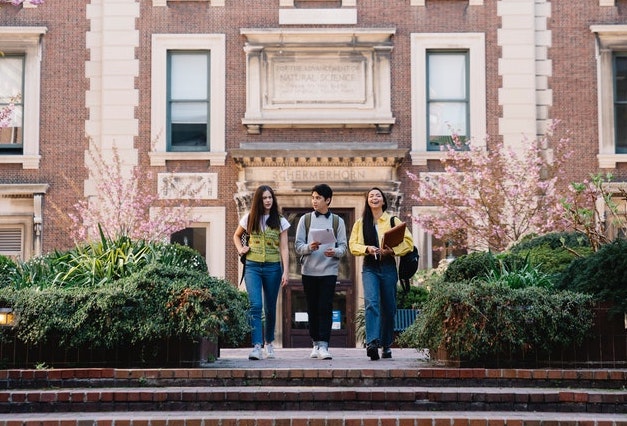
Table of Contents
STEP 1: Find and Confirm Your Housing In The U.S.A. As an international student
American college students usually have options to live in on-campus dorms (residence halls) offered by the U.S. university. The housing accommodations offered by U.S. universities vary widely among different schools. For example, some U.S. colleges require freshman (first year) to live in dorms, some U.S. colleges offer dorms for all four years and some only offer dorms for the freshman class, some do not offer any housing accommodation…etc.
The most common housing accommodation for international students would be:
- Dorms (Residence Halls)
- On-campus Apartment or Houses
- Off-campus Apartment or Houses
- Fraternity or Sorority Houses
Dorms (Residence Halls)
Dorms (residence halls) are usually a shared room with another student of the same incoming class and they are usually located on-campus which means that you most likely wouldn’t need to have a car or use the bus to get to your class. Most U.S. universities will also provide meal-plans in their dining halls. Dorms in most cases would already include basic furniture like bed, mattress, table, chair…etc. This information usually would be included in your welcome package from the U.S. university. On-campus dorms would be the easier option for first year international students because you do not need to worry about legitimacy (whether it is a real or fake listing) and furniture is already included.
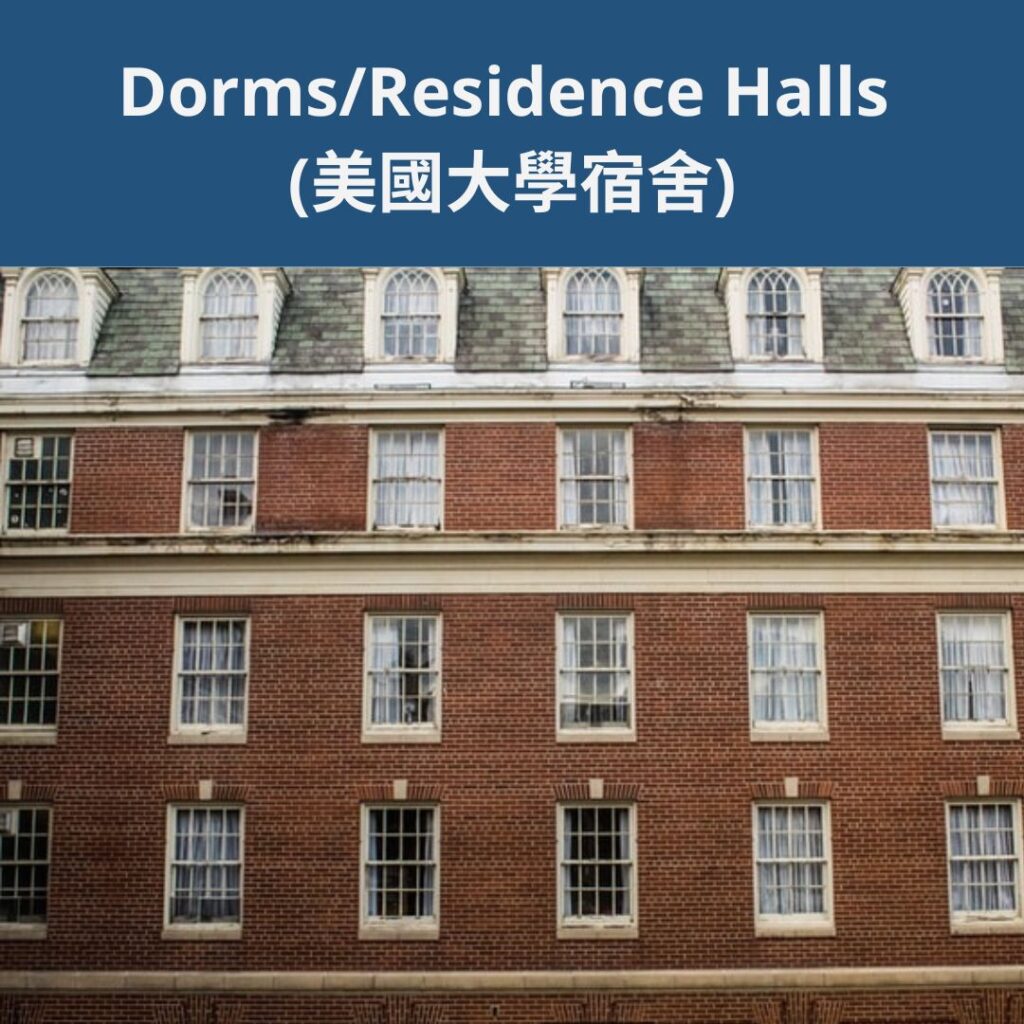
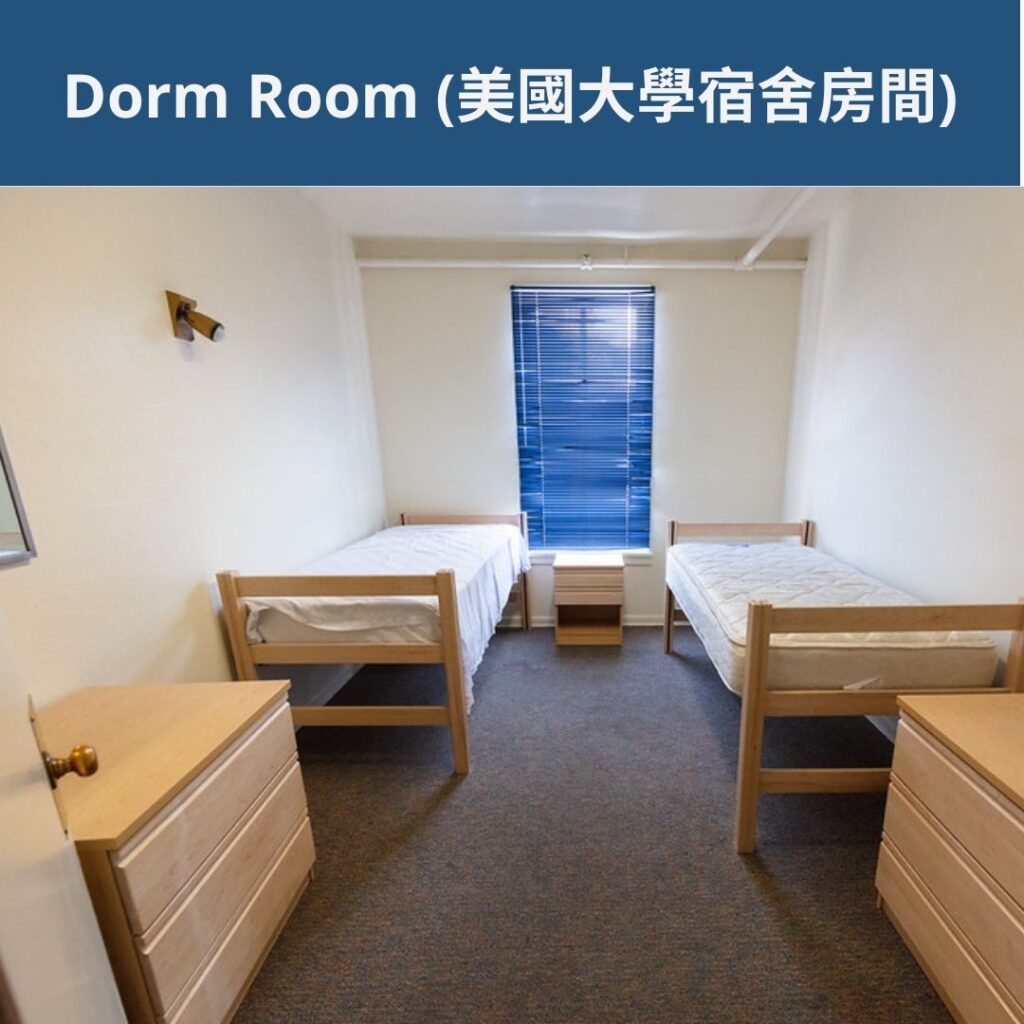
On-campus Apartment or Houses & Fraternity or Sorority Houses
On-campus apartment or houses are housing that is located near the school buildings. On-campus apartments are provided by private third-parties and you will need to do a little more research to evaluate it on your own to make sure it is legit. Usually, On-campus apartments will provide basic furniture like bed, mattress, chair, sofa, table…etc. Some on-campus apartments might offer to pair you with another resident if it is a 2 bedroom, however, if not then you will need to find a roommate yourself first.
Information about on-campus apartments usually can be found in the welcome package from your university, your university’s housing resource website, social media groups (such as facebook groups) related to your school especially with the ones that are about looking for roommates, basic google search…etc. This usually would be second easier option for international students because it is still close to school and the bigger apartment buildings usually have a reputation to confirm the legitimacy (whether it is a real or fake listing).
Houses on campus may include furniture but generally when you rent a house in the U.S.A., it does not include furniture and you will need to buy or rent furniture yourself. The most common type of houses on-campus would be fraternity or sorority houses which you would need to be accepted into first to live in those houses.


Off-campus Apartment or Houses
Off-campus apartment or houses are housing that is located farther away from the university buildings. This is not recommended to first-year international students unless you are already familiar with the area. You would usually need a car, bike, or some sort of public transportation (bus or train) to commute to school. Usually when renting an apartment or house in the U.S.A., it does not include any furniture so you would need to buy or rent furniture yourself. Off-campus apartment or houses would be a better option maybe in your second or third year because it would be a lot of work for a first year international student.


U.S.A. Apartment or House Rental Platforms
Commonly used online platforms to search for apartment or house rentals in the U.S.A. are listed below:
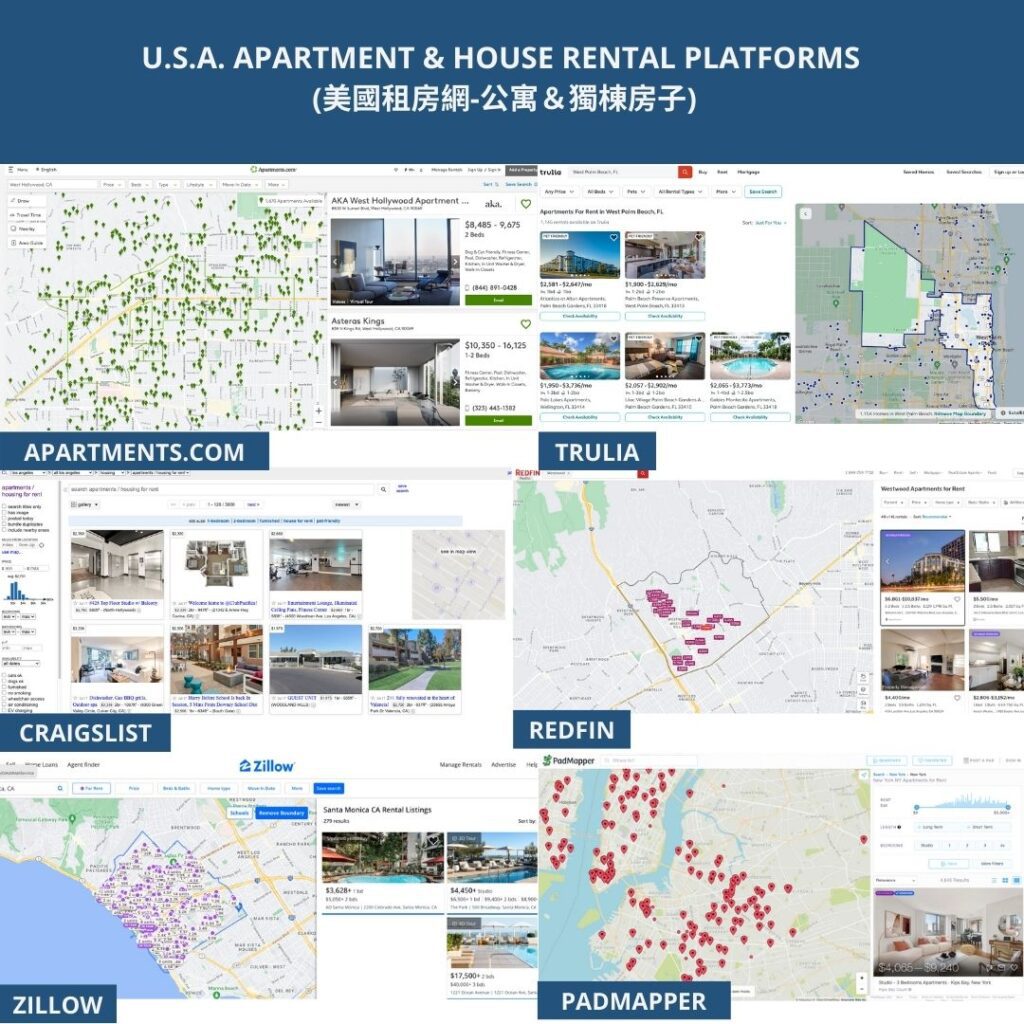
International Student Housing Conclusion
For first year international students, it is recommended to choose on-campus dorms offered by the school or on-campus apartments offered by private third-parties because it is closer to your classes, you don’t need to worry about legitimacy (where it is a real or fake listing), you usually well get to know new roommates who are students like you, and most importantly the people managing these type of housing understand the issues of international students much better which makes it much easier for you.
STEP 2: Get a U.S. Cellphone Number as an international student
Before flying to the U.S.A. to study as an international student, you would want to buy a pre-paid U.S. cellphone number just like you would when you are traveling to another country as a tourist. The SIM card can be used so you will have internet service as soon as you land. You can choose to get a pre-paid plan for a month or less and then when you get the U.S.A., you can then choose to get a plan from a major U.S. carrier instead.
Some international students will join a mobile phone family plan with friends because it might be cheaper, however, there are a lot of options of cheap mobile phone plans to choose from now so getting a mobile plan by yourself can still be cheaper. You will need to do some research to see if the mobile phone network you plan to buy into works well in your area.
The bigger mobile phone networks in the U.S.A. are:
- AT&T
- Verizon
- T-mobile & Sprint
- Mint Mobile (cheaper but need to check coverage in your area)-you can use this referral link to get $15 dollars for your account
- Tello (cheaper but need to check coverage in your area)- you can use the referral link or referral code P32BC25P to get $10 dollars for your account
Conclusion: If your university is in a city area, you should be able to use cellphone networks such as Mint Mobile or Tello which will usually be much cheaper than the traditional AT&T, Verizon, T-mobile networks, however, some areas may still require you to use the traditional networks because of better coverage. There are a lot of different mobile phone carriers and plans in the U.S.A. and will need you to do some research on what works best for your situation.
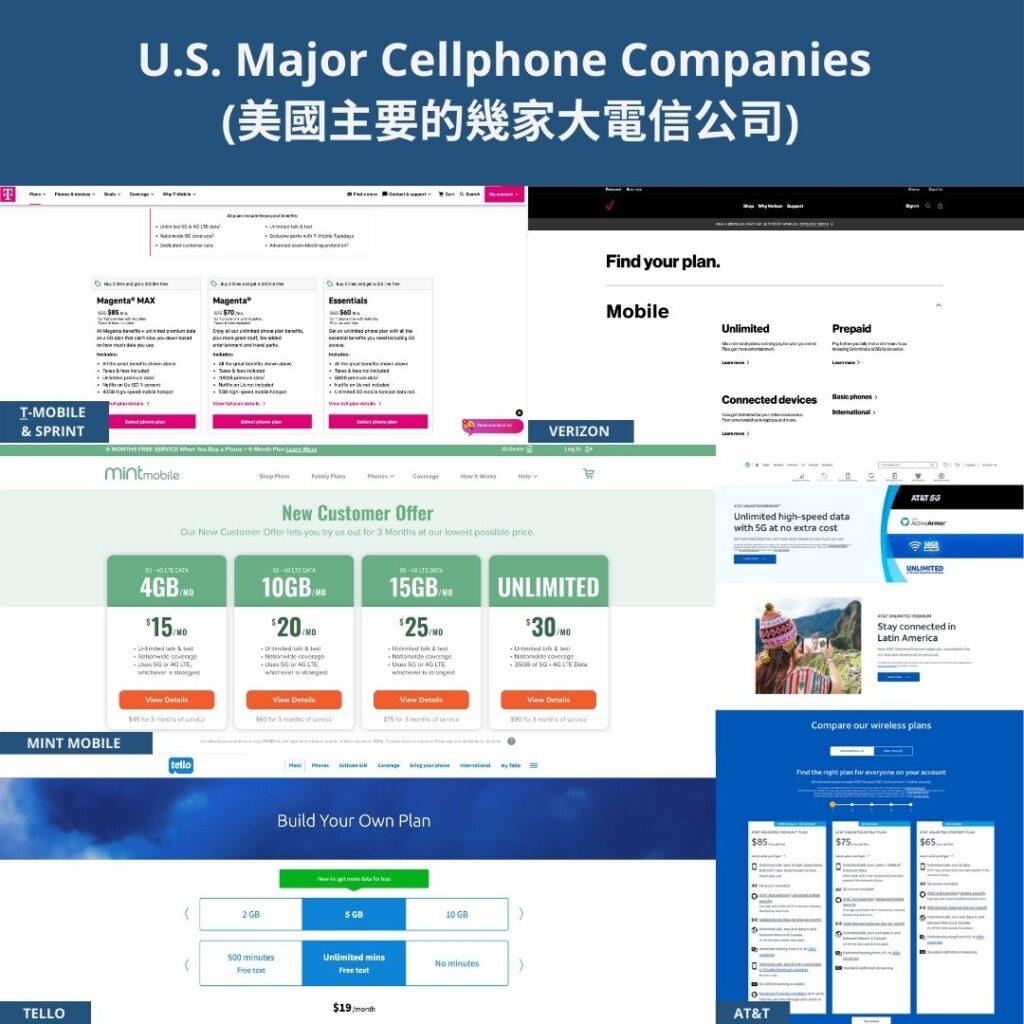
STEP 3: Health & Vaccination Records of international students
Before checking in to fly to the U.S.A. to study as an international student, your U.S. university will notify what type of health and vaccination records it requires for their students. Please check in with the U.S. school for their policy especially for the COVID-19 vaccine because it is constantly changing.
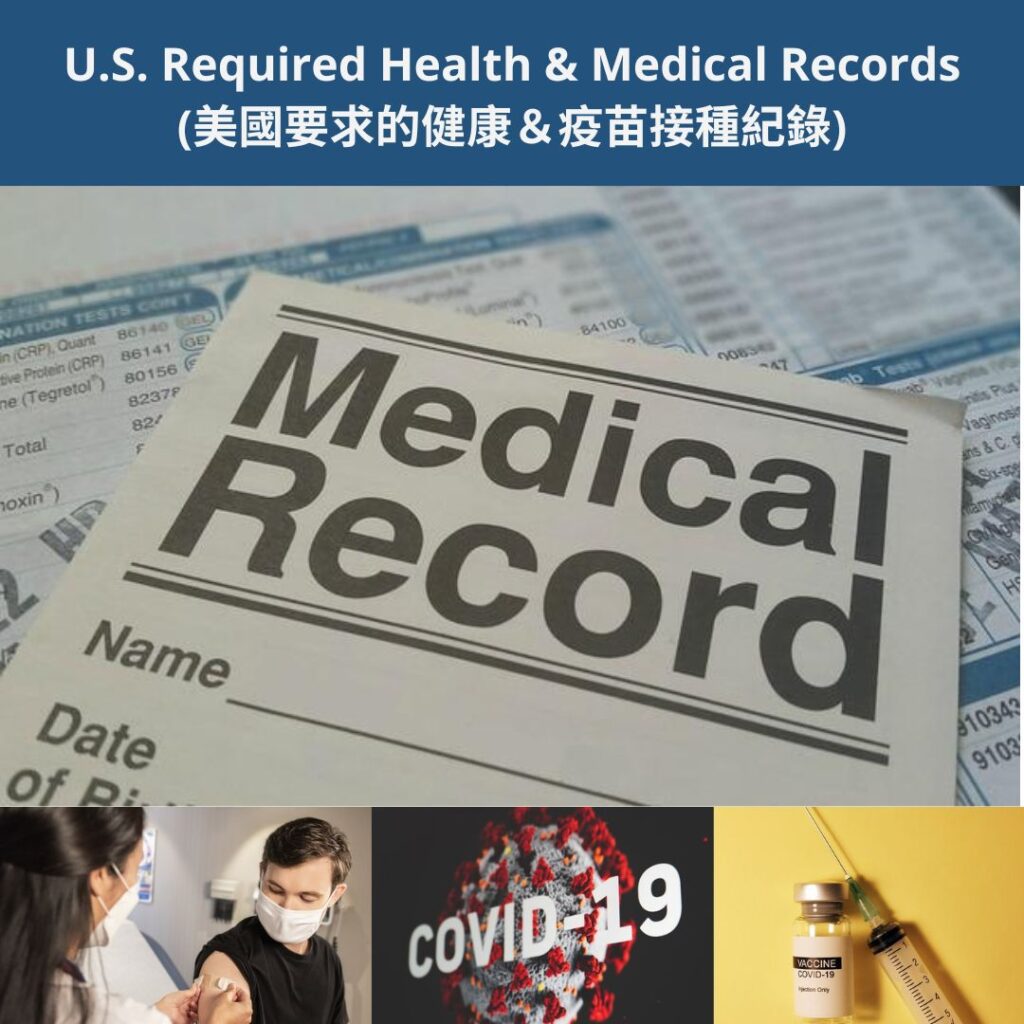
STEP 4: Order Plane Ticket To The United States to study as an international student
For most U.S. student visas, you are allowed to enter the United States in the 30 days before your educational program starts. Do not book a plane ticket that has a date earlier than 30 days of your educational program start date listed on the I-20/DS-2019 document because you will be denied entry to the U.S.A. (unless you have another valid U.S. visa) and be put back on a return flight to where you flew from.
There are multiple price comparison website to find cheaper plane tickets:
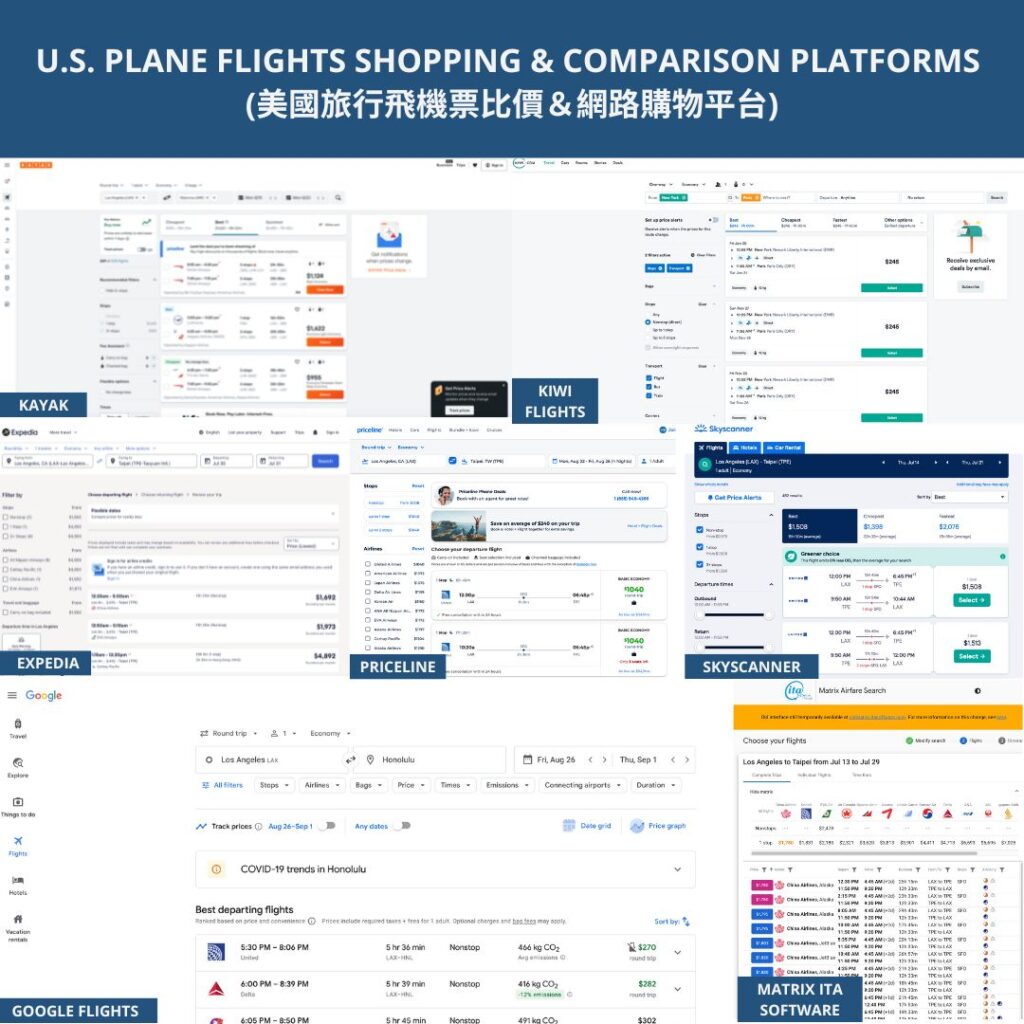
STEP 5: Pack Your Daily Essentials (Clothes, Personal Hygiene Goods, Electronics, Medicine) to study in the u.s.a. as an international student
Packing to study in the U.S.A. as an international student usually would be light because most airplane carriers only allow 2 check-in luggage (i.e., 2 suitcases), 1 carry-on bag, and 1 personal bag with a maximum weight limit for international flights. Different ticket class has different allowance with luggage as well. For example, China airlines allows 2 checked baggage (23 kg for each piece), 1 carry-one baggage (7kg), and 1 personal bag for the Standard Economy Class, but allows 2 checked baggage (32 kg for each piece), 2 carry-one baggage (7kg for each piece), 1 personal bag for the Standard Business Class.
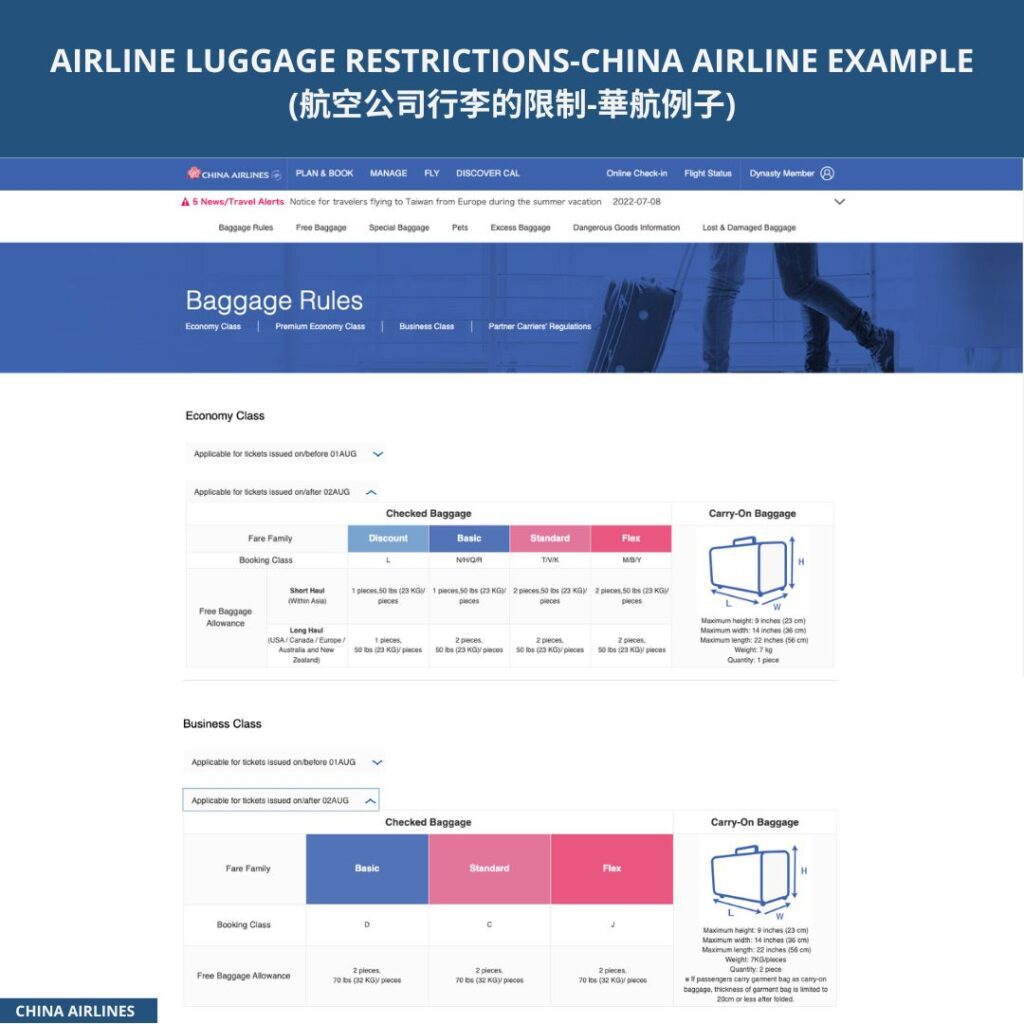
Tip: Checked-in baggage are suitcases where you give the airline staff at check-in. Carry-on bags are the bags that you put in the airplane storage above you, such as the backpack that carry’s your laptop. The personal bag is the bag that you put under your seat, such as the bag that has your passport, pen, money in it.
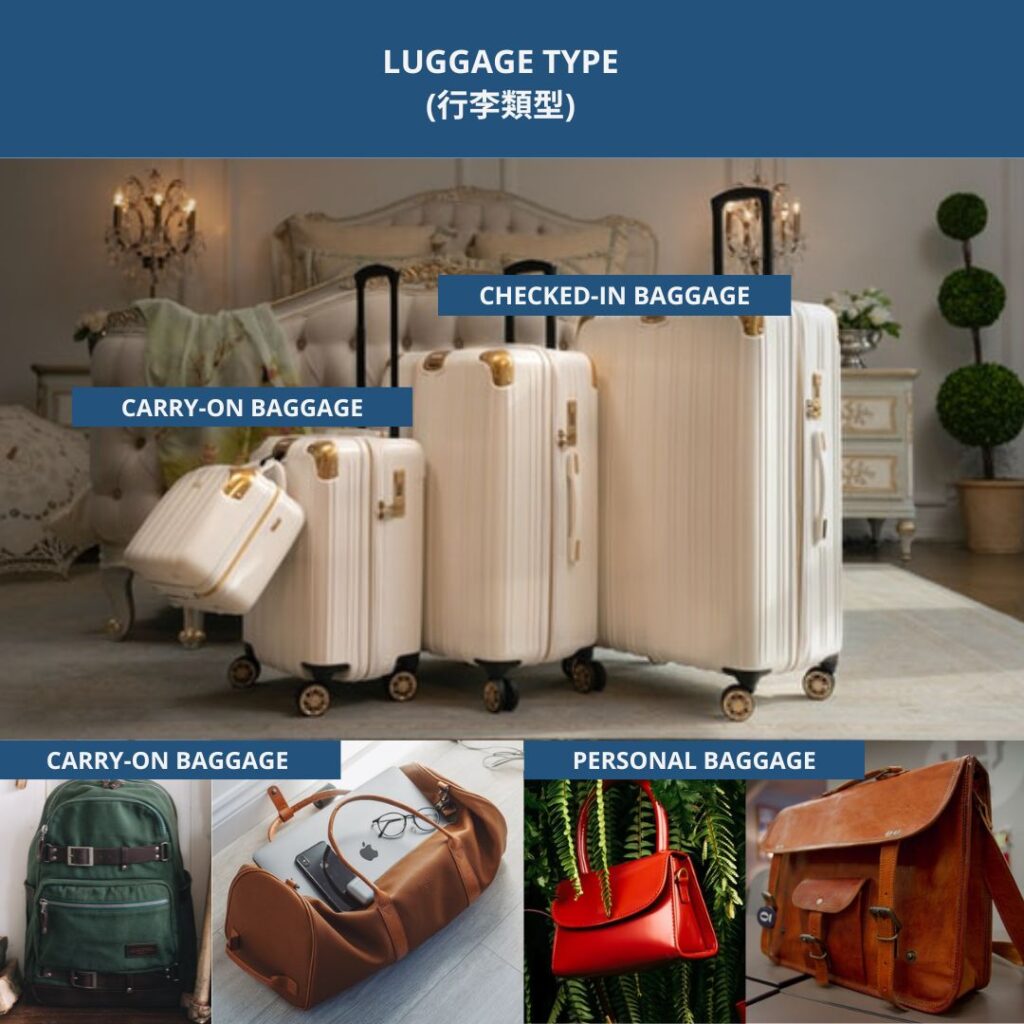
Please first check your airplane carrier to know how much luggage your ticket allows you to bring before you pack your bag. After checking how much luggage you can check-in to your airplane, you would need to start packing items that you know you will be essential to your daily living.
Clothing For International Students To Pack For Checked Baggage
- Tops (long-sleeves shirt, short-sleeve shirts, hoodies, sweatshirts, tank tops)
- Bottoms (jeans, skirts, shorts, leggings)
- Outerwear (jackers, coats)
- Dresses
- Formal outfit (suits for internships)
- Shoes (dressing shows, sneakers, heels, flip-flops, sandals)
- Pajamas
- Swimsuit
- Active wear (sport clothes)
- Underwear
- Socks, Hats, Gloves, Scarfs, Belts
- Sunglasses & Glasses
- Bags (backpack, purses, wallet)
- Jewelry
Personal Hygiene Goods & Medicine For International Students To Pack For Checked Baggage
- Prescription Medicine
- Contact lenses & Content lenses disinfectant liquid
- Hair styling tools (hairbrush, iron curler, flat iron, comb, blowdryer)
- Makeup
- Perfume
Items That You Don’t Need To Necessarily Pack As An International Student (Items That Can Be Easily Bought In The U.S.A.)
Some items can be very easily bought and not necessarily more expensive in the U.S.A. so you can consider taking these types of items out of your baggage if you are running out of space in your suitcase.
- Soap or Shower gel
- Shampoo & Conditioner
- Deodorant
- Shaver, Razors
- Toothbrush & Toothpaste
- Nail Clippers
- Sunscreen
- Lotions
- Bedsheets, Blanket (Comforter, Duvet), Pillow
- Towels
- School Supplies (notebooks, pens, folders)
- Umbrella
Electronic For International Students To Pack For Carry-On Baggage
- Smartphone
- Laptop
- Camera
- Powerbank
- Headphones
- Charger
- Power outlet adapters (if the power sockets and voltages are not the same in the U.S. which is 120V)
Essential Items To Bring In Your Personal Bag As An International Student
- Passport & All visa related documents
- Vaccination records
- Plane ticket
- Money (credit card & cash less than $10,000 USD because if you bring more than $10,000 USD, you will need declared it in the Customs Declaration Form 6095B and FinCEN Form 105)
- Pen
- U.S. mobile phone SIM card
- Phone, Laptop, Camera
- Medicine
- Tissue
According to the U.S. Transportation Security Administration (TSA), any liquid, gel, cream paste, aerosols you put in your carry-on bag must be put into a 1-quart-sized resealable bag (e.g., Ziploc bags) and each item must be in small travel-sized containers that are 3.4 ounces (100 millimeters) or less. It is recommended to not bring these types of items in your carry-on bag unless it is necessary for you to use on the plane flight to avoid potential issues.
Tip: Have Your U.S. Address On Hand & Pen
You will be asked to fill out a Customs Declaration Form (Form 6059B) before you get to the CBP officer at the U.S. airport and it will ask for the U.S. address you will be living at so please have the U.S. address of your dorm, apartment, or house somewhere easy to access. In most cases, the flight attendants will be handing the customs declaration form out shortly before you land in the U.S.A. and you will be filling it out by hand at that time so please remember to bring a pen with you when you fly.
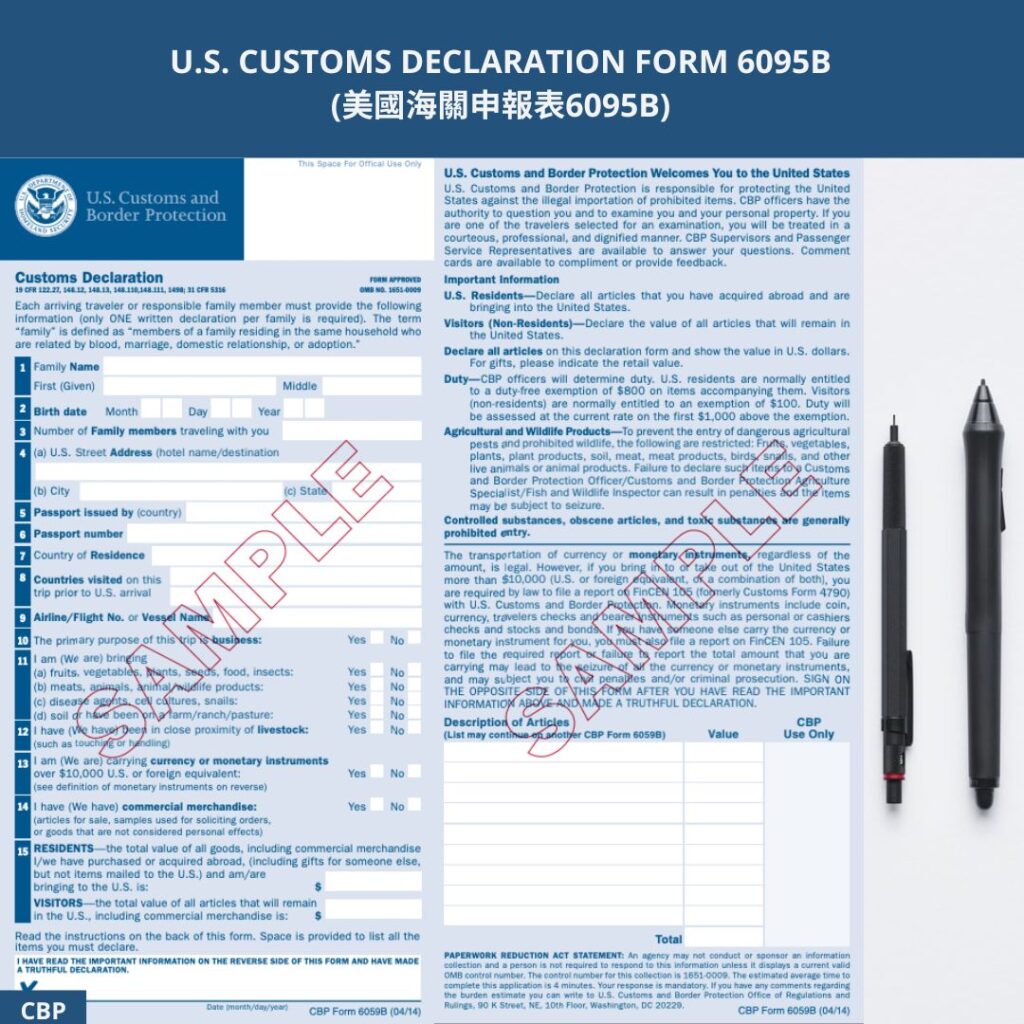
STEP 6: Make Sure You Have Your Nonimmigrant Student Visa (F1 Student Visa, M1 Vocational Student Visa, J1 Exchange Student Visa) & All Other Proof That You Are Accepted As An International Student In A U.S. School
Before flying off to study in the U.S.A. from your home country, you would need to make sure that you have the required travel and immigration documents that allows you to enter the U.S.A. The travel and immigration documents should show that you have been accepted to a U.S. school and that your U.S. student visa has been approved by a U.S. consulate.
Make Sure Passport Has A 6 Month Validity Time Period
Generally, foreign visitors including international students are required to have a passport that has at least a 6 month validity time period, which in simpler words are that the passport cannot not expire within 6 months. However, there are numerous countries that do not require a 6-month validity time period. Please check the list below and double check your passport’s country here because it gets updated from time-to-time.
Updated March 2022 | |
|---|---|
Andorra Angola Antigua and Barbuda Antilles Argentina Armenia Aruba Australia Austria Bahamas Barbados Belgium Belize Bermuda Bolivia Bosnia-Herzegovina Brazil Bulgaria Burma Canada Chile Colombia Costa Rica Cote d’Ivoire Croatia Cyprus Czech Republic Denmark Dominica Dominican Republic Egypt El Salvador Estonia Ethiopia Federated States of Micronesia Fiji Finland France Georgia Germany Greece Grenada Guatemala Guinea Guyana Haiti Hong Kong Hungary Iceland India Indonesia Ireland Israel Italy Jamaica Japan Kosovo Latvia Lebanon Libya Liechtenstein Lithuania Luxembourg | Macau Madagascar Maldives Malaysia Malta Mauritania Mauritius Mexico Monaco Mongolia Montenegro Mozambique Nepal Netherlands New Zealand Nicaragua Nigeria North Macedonia Norway Pakistan Palau Panama Papua New Guinea Paraguay Peru Philippines Poland Portugal Qatar Romania Russia San Marino Saudi Arabia Serbia Seychelles Singapore Slovakia Slovenia South Africa South Korea Spain Sri Lanka St. Kitts and Nevis St. Lucia St. Vincent and The Grenadines Suriname Sweden Switzerland Taiwan Thailand Trinidad and Tobago Tunisia Turkey Tuvalu Ukraine United Arab Emirates United Kingdom Uruguay Uzbekistan Vatican City- Holy See Venezuela Zimbabwe |
Gather Proof That You Have Been Accepted As An International Student In A U.S. School
The most important document that shows you are an M1 visa or F1 visa international student in a U.S. school is your I-20 document (Form I-20 Certificate of Eligibility For Nonimmigrant Student Status). The I-20 contains information such as your name, the country you are from, what school you are attending in the U.S., the degree program you will be studying in, when your classes start and end, your financials…etc. For J1 visa students, the comparable document would be the DS-2019 document (Certificate of Eligibility for Exchange Visitor (J-1) Status).
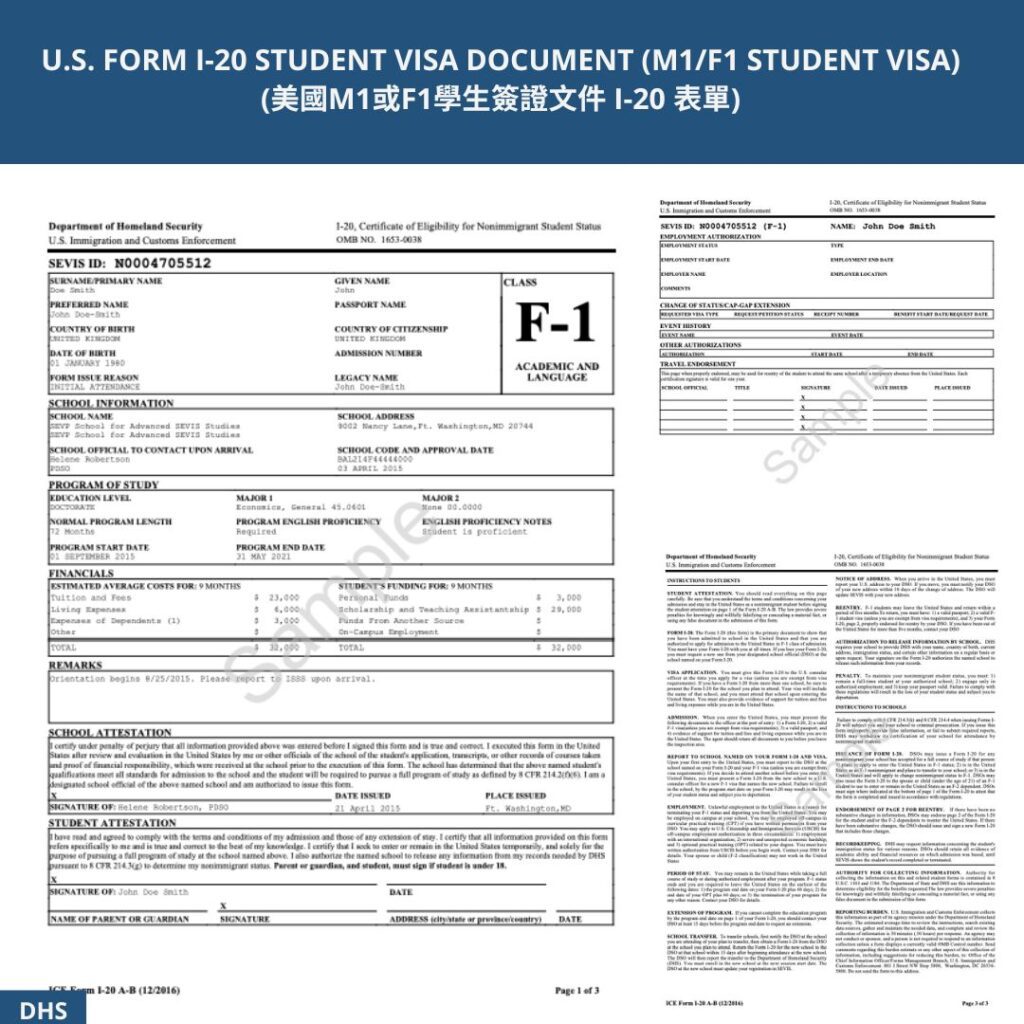
Click to download a Form I-20 sample.
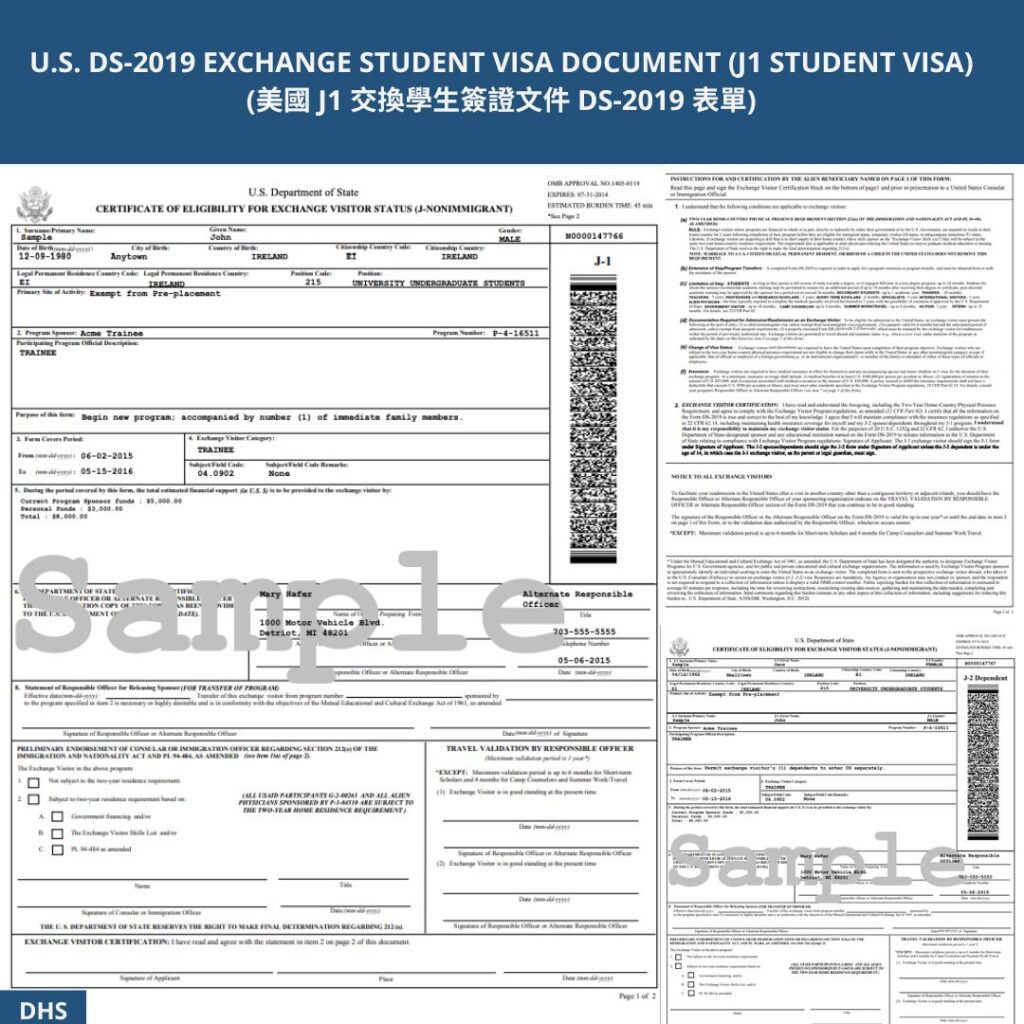
Click to download a DS-2019 sample.
IMPORTANT: Always Carry Your I-20/DS-2019 When Traveling as an international student
You must always keep your I-20/DS-2019 in a safe place because this is a very important document as an international student. You MUST always carry the I-20/DS-2019 document with you whenever you are traveling especially when you are traveling internationally (flying in and out of the U.S. or crossing country borders such as driving to and from Canada or Mexico).
You MUST also always remember to obtain a travel endorsement signature (on your I-20/DS-2019 document) from the International Students Department of your U.S. school BEFORE traveling internationally. The signature from the International Students Department of your U.S. school shows that you are approved to travel internationally. The names for the international students department may vary for different schools, for example the international students department for University of Illinois Urbana-Champaign is called “International Student and Scholar Services” and for University of Southern California it is called “Office of International Services.”
Each U.S. school has their own processing time and procedures to apply for a travel endorsement signature so please always plan ahead when traveling internationally. If you forgot to obtain the travel endorsement or left your I-20/DS-2019 student visa document in the U.S. before you left the U.S. to travel internationally, you may still be able to obtain a newly signed I-20/DS-2019 document from your school’s international students department. If you encounter these types of issues, please contact your school’s international students department immediately and this is preferably done before checking in or boarding on your flight back to the U.S.A.
When You Don’t Have Your I-20/DS-2019 or An Approved Signature On Your I-20/DS-2019 When Returning To The U.S.A. as an international student
If you do not carry your I-20/DS-2019 document or do not obtain an approved signature from the International Students Department, you most likely will be taken to the secondary inspection room when you are re-entering the U.S.A. The CBP officer most likely will contact the U.S. school (usually there will be an emergency line/contact person for these type of situations at your school) and then allow you in with a Form I-515A. However, in rare circumstances you may be sent back on a flight to the country you flew from. So for best practices, please remember to have your signed I-20/DS-2019 ready before you leave the U.S.A. for all international trips.
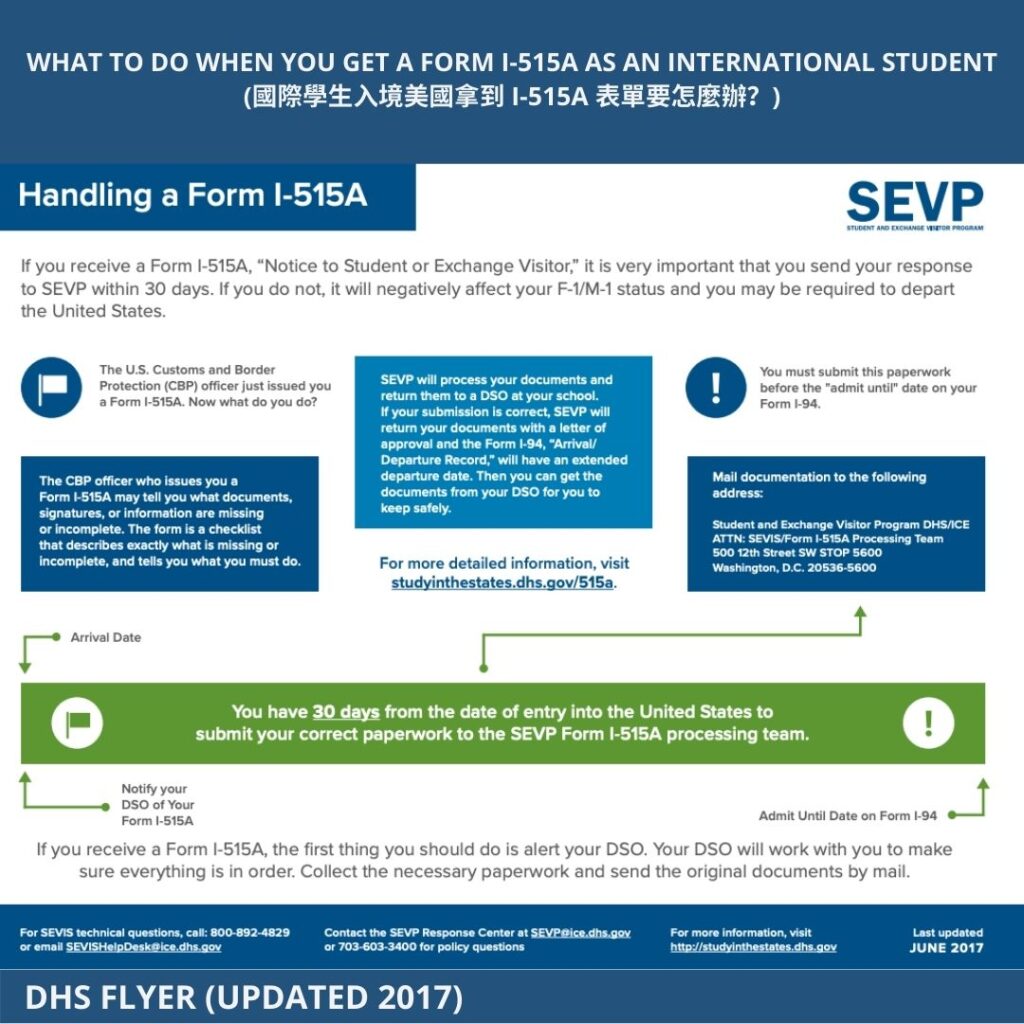
Form I-515A Temporary Entry To The U.S.A. as an international student
The Form I-515A (Notice to Student or Exchange Visitor) allows you to temporary enter the U.S.A. for 30 days, however, you must correct this temporary expiration date back to your original student visa validity time period. After receiving the Form I-515A and entering the U.S.A., you must contact the international student and scholar services of your school and submit a new Form I-20/DS-2019, Form I-94, Form I-515A, copy of the admission stamp in your passport, and I-901 SEVIS Fee receipt to the SEVP government agency address listed on the Form I-515.
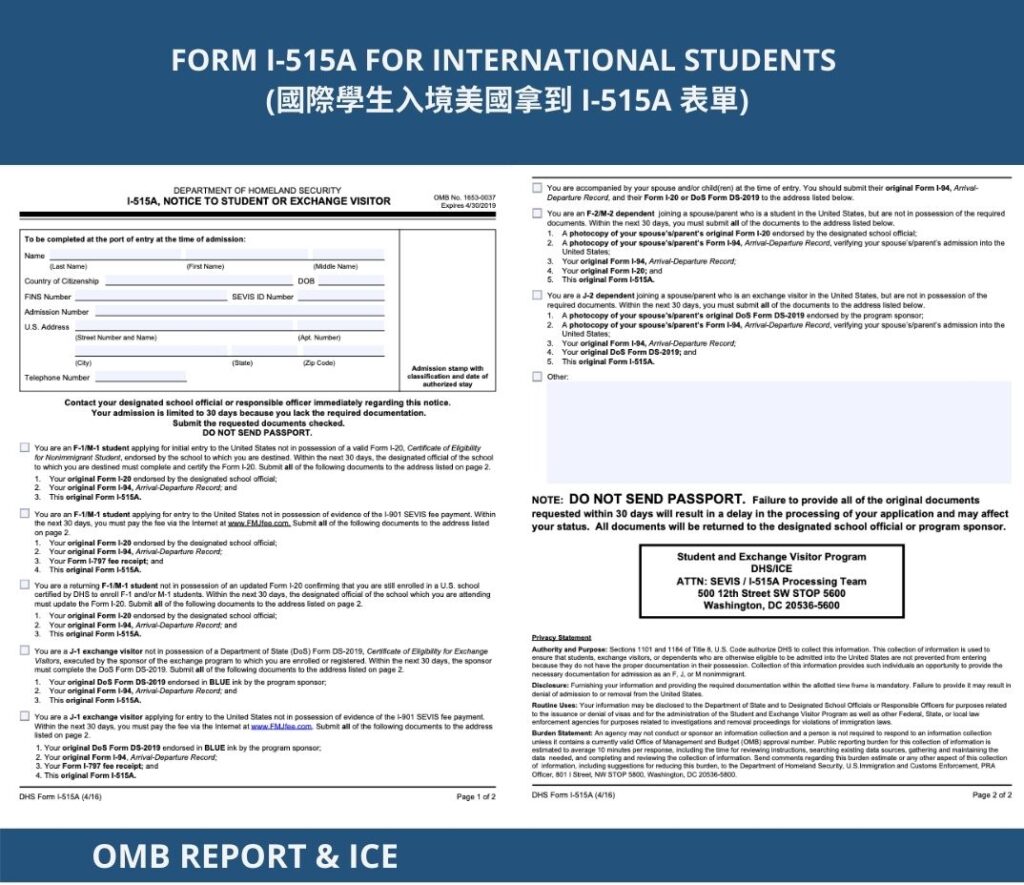
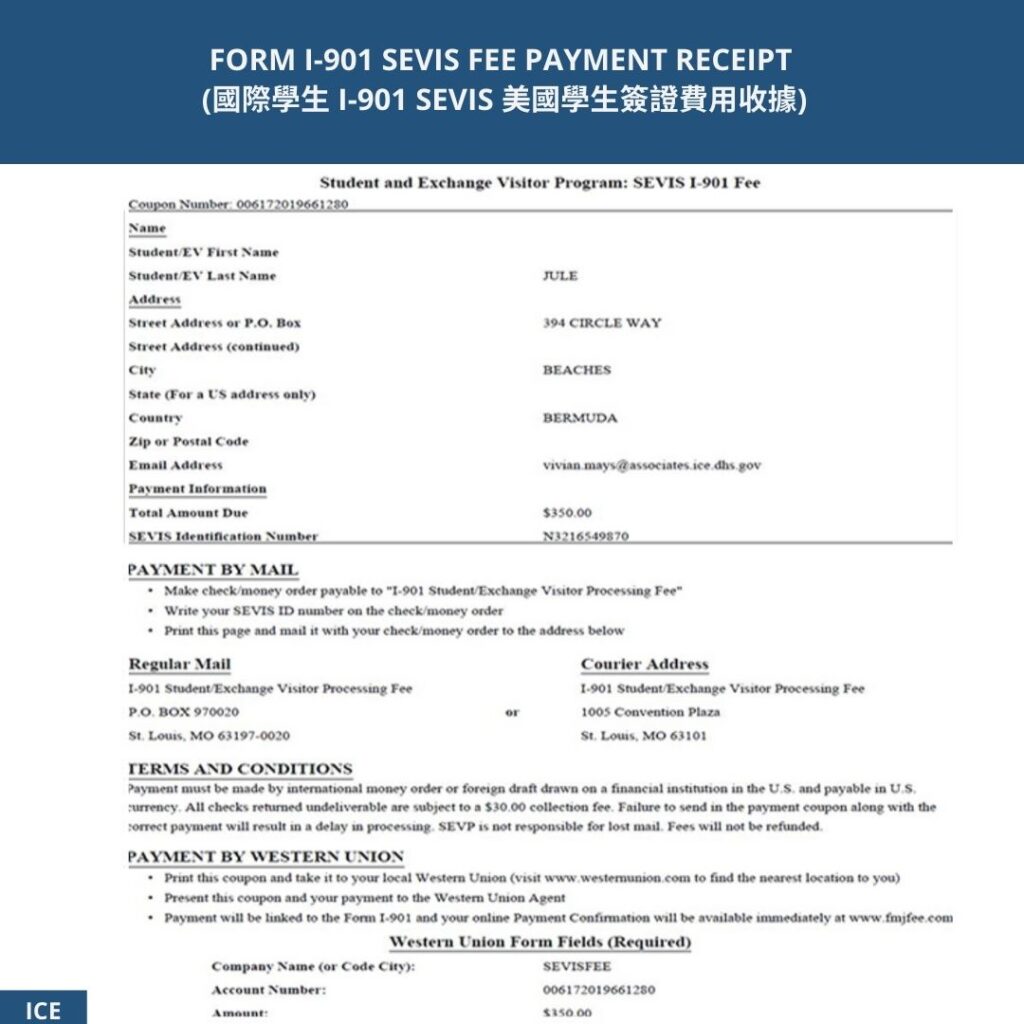
All Other Supporting Documents As An International Student Accepted To A U.S. School
To be safe at the U.S. port-of-entry (such as the U.S. airport), it is recommended that you bring a copy of all the supporting documents showing that you are indeed accepted as an international student by a U.S. school. These type of documents usually won’t be used or asked for if your I-20/DS-2019 and student visa stamp in your passport are correct and you answer the questions of the CBP appropriately, however, just to be safe please gather all the documents that support the reason you are entering the U.S.A. (so in this instance would be studying in a U.S. school as an international student).
These type of documents usually include the documents that you used when you applied for your student visa at the U.S. consulate, such as bank statements, Form DS-160 nonimmigrant visa application, I-901 SEVIS fee receipt, acceptance letter from U.S. school, college enrollment package from U.S. school, your past academic degree and transcripts…etc. Put all the relevant documents into a folder to be organized and prepared and bring it along with you when entering the U.S.A.
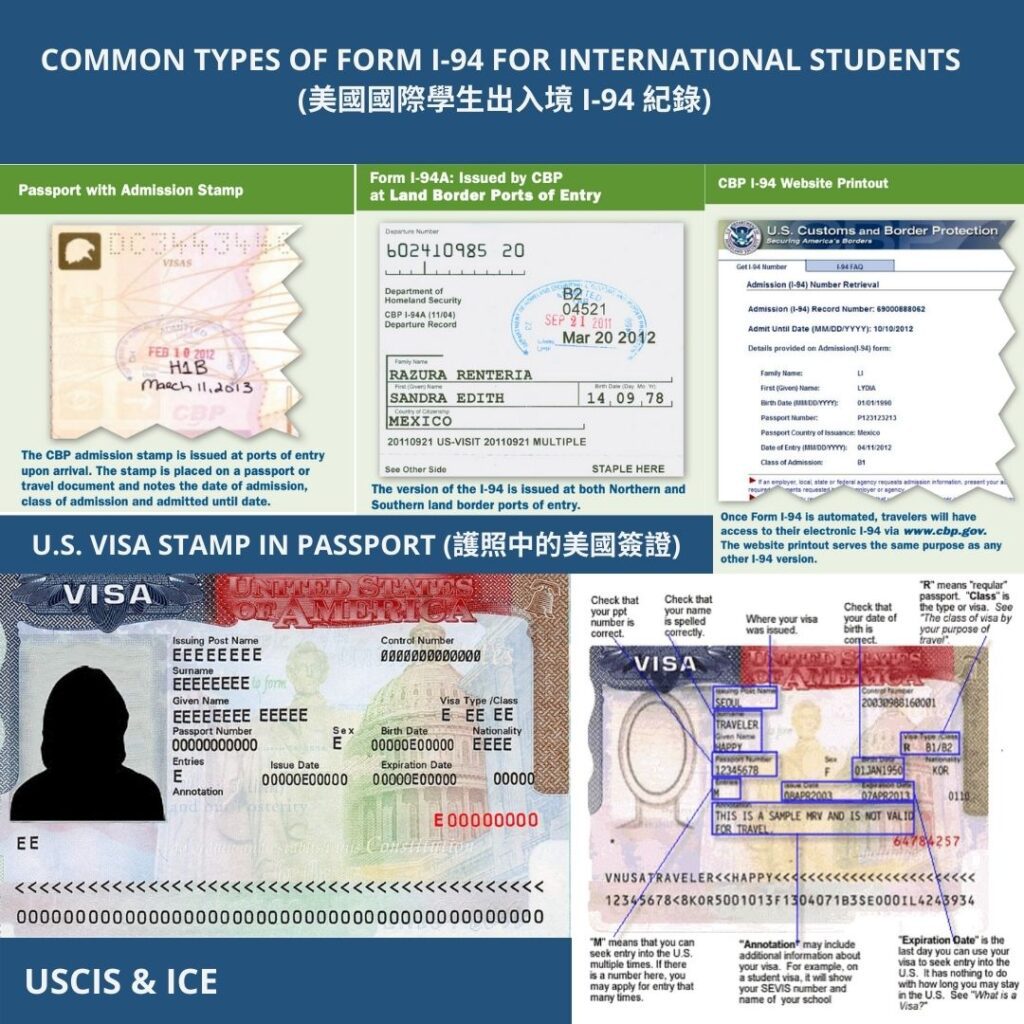
RELATED ARTICLES
- H1B Work Visa (Specialty Occupations)
- Employment-Based Green Card Overview (Lawful Permanent Resident)
- Family Based Green Card Overview
- Marriage Based Green Card (IR1 / CR1 / F2A)
- Useful Apps to Download While Living in the U.S.
- A Guide to Moving in the United States of America (USA)
- A Guide to Searching and Renting Apartment or Houses in the U.S.
- A Guide for International Students Studying in the U.S.
- A Checklist of Things that an International Student Should Prepare Before Coming to the U.S.
- A Checklist of Things that an International Student Would Need After Arriving to the U.S.
- A Guide to Grocery Shopping in the United States of America (USA)
- Shopping Luxury or Designer Goods While in the Living in the U.S.

